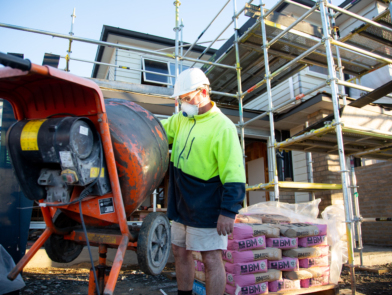- There are a lot of construction tools that create small particles of dust.
- These small dust particles will float around in the air after the tool work has finished.
- You can inhale these airborne dust particles deep into your lungs.
- Which can cause significant problems to your health down the line.
Silica Dust & Respiratory Disease
Silica is a natural substance found in such construction site materials as concrete, bricks, rocks, stone, sand and clay. Silica when it’s intact is harmless. However, when it is cut, ground, drilled or otherwise disturbed silica is released as fine particles and can be inhaled deep into the lungs. Breathing excessive amounts of silica can cause a potentially fatal lung disease called silicosis and has been linked with other respiratory diseases.
Wood Dust & risks to health
Wood processing causes small particles of wood dust to become suspended in the air. Workers can inhale these particles. A person’s upper respiratory system can filter out the larger particles, but smaller particles can go deep into the lungs causing damage and scarring to the lung tissue. Each time this happens a small amount of irreversible damage occurs. This damage reduces the lungs’ ability to take in oxygen and over time makes it increasingly difficult to breathe and can lead to health complications such as asthma. Skin contact with dust especially wood dust can cause ulceration of the skin, irritation and dermatitis. The presence of glues, resins, formaldehyde, arsenic, boron and other wood treatment chemicals in some wood products increase the health risks from wood dust.
- Tasks that expose construction workers to dust hazards
- Sawing, hammering, sanding, routing, drilling or grinding of bricks, stone, wood or other fibre cement products e.g. Linea Board.
- Concrete mixing, cutting, drilling, chipping, etching or abrasive blasting.
- Hauling, dumping, chipping, hammering and drilling of rock.
- Dry sweeping or using pressurised air to blow concrete, rock, sand or wood dust.
- Demolition of concrete or masonry and buildings.
- Bagging dust from dust extraction systems then emptying them into skip bins.
- Site excavations and landscaping
Dust Control
The key to preventing dust exposure is keeping dust out of the air. This can be achieved by:
Vacuum Extraction: The most effective way to control dust is by using on‐tool extraction / vacuum systems to control dust at source. Purchase tools which feature a “tool‐start” vacuum attached to a HEPA (high efficiency particulate air) filter.
Wet Work: Wet work methods are also effective in controlling dust. Wet‐machining processes (e.g. concrete wet‐saw) should be used in preference to dry‐machining. Water hoses should be used to wet down any dust created before it becomes airborne and to frequently clean equipment.
Dust‐reducing Equipment: Use cutting equipment and methods which minimise dust. Dust‐reducing circular / drop‐saws should be used in conjunction with dust‐reducing blades which generate larger (and less respirable) dust particles. Where practicable, other hand machining tools or cutting methods (e.g. score‐and‐snap) may be options. Equipment should be maintained and frequently cleaned to ensure efficient operation.
Adequate Ventilation: Always undertake machining of dust producing products in well‐ventilated outdoor areas. Consider prevailing winds and warn others in close proximity. Use the hazard board to communicate with others and setup an exclusion zone using cones or tape. If machining is to occur indoors then appropriate controls need to be established e.g. dedicated containment room with exhaust extraction, etc.
Cleaning Practices: Do not dry sweep. Dust should be removed from work areas using vacuums with HEPA filters or a water hose.


